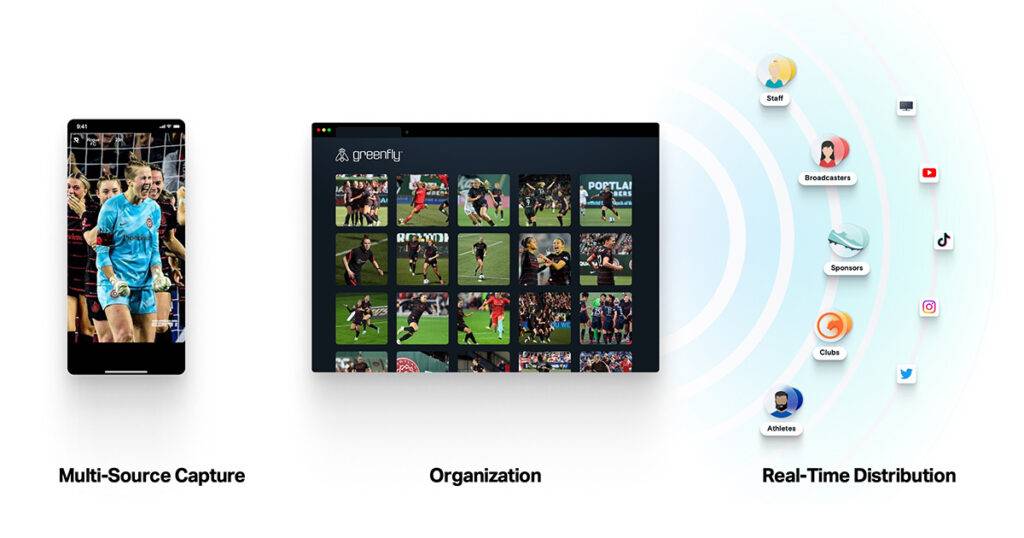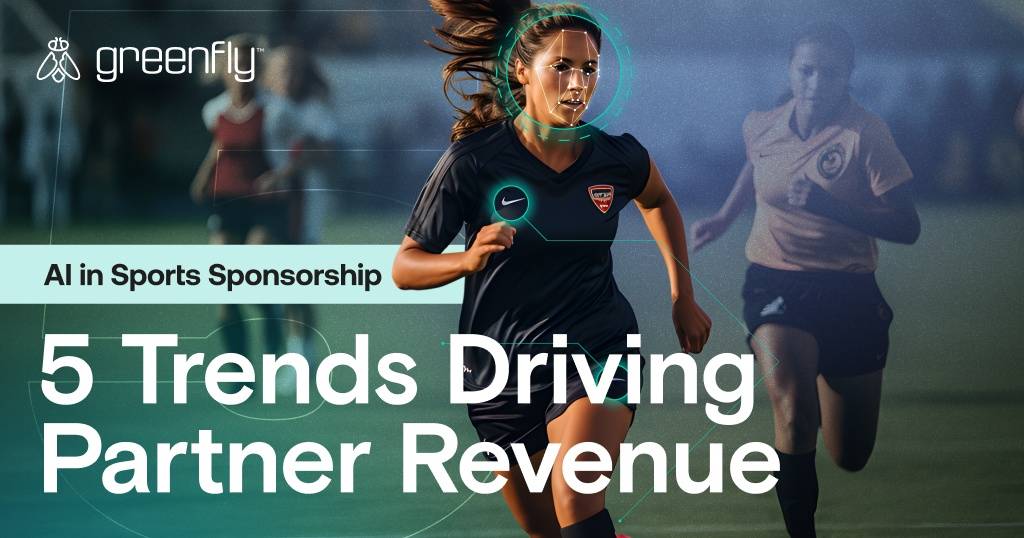Fans experience brands and their favorite sports leagues, teams and players on digital platforms. Because the entire world has shifted to mobile-first, digital media like photos and videos matter more than ever. Many sports leagues and teams are taking a more advanced and comprehensive approach to digital media workflow operations, far beyond automation. Processing thousands of assets and making them accessible to hundreds or thousands of recipients requires next-generation tech infrastructure. It requires short-form media orchestration (SMO).
What is a Short-Form Content Orchestration Platform?
A short-form media orchestration platform is a comprehensive software solution that enables organizations to automate the many processes involved in of capturing, aggregating, managing and distributing digital media assets to provide access to multiple stakeholders, channels and platforms. It serves as a centralized hub for organizing and delivering digital media content cohesively and efficiently. It’s the key to driving digital fan engagement for digital-first or digital-only fans.
By leveraging a short-form media orchestration platform, organizations can engage their fans on more screens with more consistency. And they can cultivate a passionate fan base anywhere in the world.
Adding a SMO platform to your tech stack will improve operational efficiency, enhance collaboration with both internal teams and partners, and ensure brand consistency. With it, sports and media organizations can deliver engaging, personalized digital media experiences across channels. This capability ultimately maximizes the impact and value of their digital media assets.
Short-Form Media Orchestration Platform Features
Key features of a digital media orchestration platform include:
- Content Capture: A short-form media orchestration platform can natively capture and sync digital media assets from photographers and creators at live events. Then it can import them into the platform, along with tags and metadata. An optimized mobile upload experience ensures that large video and image files captured on phones or pro cameras can be uploaded in bulk immediately after capture without loss of quality.
- Subject Recognition and AI Tagging: A SMO provides automated subject recognition for photos and videos. And it can identify people, teams, logos and scenes using machine learning and AI technologies. Assets can be tagged with keywords that provide information about each asset, enabling automated rules-based organization.
- Asset Management: A SMO platform provides robust capabilities for storing, sorting and managing various types of digital media assets, such as images, photos and videos. It includes features for metadata tagging, version control and asset lifecycle management. Many of these capabilities are also found in DAM and MAM systems.
- Workflow Automation: A SMO platform automates repetitive tasks and workflows involved in creating, producing and distributing digital media content. It allows users to define and execute automated workflows, including file transcoding, resizing, format conversion, and content approval processes.
- Collaboration and Review: A SMO platform facilitates collaboration among team members. It allows them to work together on assets, review and provide feedback, and track changes in real-time. It often includes features such as annotations, commenting, and approval workflows to streamline the review and approval process. Round-trip collaboration with external partners, like players and sponsors, can result in original and authentic — and professionally edited — content.
- Distribution and Publishing: A digital media orchestration platform enables the seamless distribution of digital media assets to different parts of an organization, different teams, and even external partners. SMOs use various channels and galleries to keep content separated for different needs and usage rights. SMOs can be directly integrated with social media platforms, content management systems (CMS), video platforms, and other distribution channels. These integration capabilities make it fast and easy for teams to publish and distribute content across multiple channels simultaneously.
- Analytics and Optimization: Additionally, a SMO platform provides insights into asset performance, user engagement and audience behavior. It offers analytics and reporting features to track many activities. These include social media impact, sponsor value, and digital media campaigns. And a SMO can optimize content strategies, so content teams can make smarter data-driven decisions.
Not every platform has comprehensive coverage of all of these areas. Most, in fact, do not facilitate content capture. Rather, they rely on other systems or processes to feed content into their system.

What’s the Difference Between Orchestration and Automation?
Regarding digital media workflows, automation refers to implementing streamlined and efficient workflows for individual tasks handled without human oversight. Automation can be applied to previously manual tasks in cloud environments and desktop or mobile apps. The range of tasks that can be automated is extensive:
- Tagging assets with descriptive metadata for indexing
- Moving or copying assets to one or more shared galleries
- Notifying users when new assets are added to shared galleries
Digital and social media teams can leverage automation to optimize daily tasks and enhance overall productivity. Companies across industries and sizes turn to automation to achieve efficiency at scale. As the content volume goes up, so does the need for automation.
What Does Short-Form Media Orchestration Deliver That Automation Doesn’t?
Frequently, when we talk about automation in digital media workflows, we are actually referring to orchestration. Orchestration involves automating numerous tasks together, taking automation to a more comprehensive level. It entails automating an entire end-to-end workflow process rather than focusing on a single task. Orchestrating multiple manual and automated tasks requires a deeper level of complexity and involves the following:
- Understanding and mapping out the many steps involved in the process
- Monitoring and coordinating each step across multiple environments, such as content sources, content identity, content type and media rights
Orchestration showcases a more advanced and intricate approach to automation, particularly within digital media workflows. It allows for the seamless integration and synchronization of various tasks. This capability ensures a smooth and efficient workflow across different components of digital media systems.
Media Orchestration vs. Management: What’s the Difference?
Short-form media orchestration and digital media management are two related but distinct concepts in the realm of collecting, managing and distributing digital media assets. The main difference between the two concepts is that SMO is all about video and photo capture and real-time distribution during live events. The media is accessible in seconds or minutes after capture. Conversely, digital media management is about centralized storage and version control of brand assets and photos for creative teams.
Short-form media orchestration refers to the process of coordinating and synchronizing various digital media assets across multiple platforms, channels and touchpoints to deliver a unified experience.
- It emphasizes the seamless integration and synchronization of media assets to deliver a cohesive and consistent experience to the audience.
- Digital media orchestration platforms often include features such as automated workflows, content distribution across multiple channels, real-time content updates, content personalization, and cross-channel analytics.
- SMO platforms enable organizations to streamline their content distribution, improve efficiency, maintain brand consistency, enhance the audience experience, and optimize content performance across different platforms and channels.
Digital media management refers to the process of efficiently organizing, storing and managing digital media assets in a centralized repository.
- DAMs focus on storing, retrieving and organizing digital media files, ensuring easy access, version control and efficient asset management.
- Digital media management platforms typically include features such as asset storage and organization, metadata management, version control, access controls, asset search and retrieval, and integration with other tools or systems.
- DAM systems help organizations effectively manage a small number of digital media assets, maintain asset integrity, improve creative and marketing team collaboration, reduce redundancy, and ensure efficient asset usage and distribution.
Both concepts play crucial roles for different departments in optimizing digital media workflows, enhancing audience experiences, and driving successful digital fan engagement strategies.
Direct Distribution of Short-Form Content to Fans
DAMs were designed for quick human access to approved assets. They weren’t designed to distribute volumes of content to CMS systems for direct-to-consumer (D2C) access. Deciding whether to share digital media on social media platforms by social media staff or directly to fans within a team or league’s own mobile app (like the NBA and WNBA apps) is not a one-size-fits-all answer. It depends largely on the specific goals of the sports organization.
There are many factors to consider, and your choice of short-form media orchestration system will play a major role.
- Reach and Discoverability: Social media platforms have a massive user base. They offer broader reach compared to a league’s mobile app. Sharing content on platforms like Facebook, Instagram, Twitter or YouTube can expose it to a larger audience. This potentially attracts new fans and followers. In contrast, a league’s mobile app typically caters to existing fans who have already downloaded the app to use it.
- Fan Engagement and Interactivity: Social media platforms provide interactive features like comments, likes, shares and direct messaging, allowing fans to engage with the content and each other. This activity fosters conversations, builds communities and enhances the overall fan experience. However, a league’s mobile app can offer more specialized and immersive features specific to the league (or team). These include live game streaming, player stats, interactive games and exclusive content, which can deepen fan engagement and loyalty.
- Control and Branding: A league’s mobile app provides more control over the content, design and user experience. It allows the league to curate and showcase content in a customized manner aligned with its brand guidelines. In contrast, social media platforms have their own layouts, algorithms and ad placements that can impact the presentation and visibility of content. However, strong branding can be maintained with software like Slate Teams.
- Data and Analytics: Sharing content on social media platforms provides access to robust analytics and insights. These data points help teams understand audience behavior, content performance and social media performance. They can inform future content strategies and improve targeting. On the other hand, a league’s mobile app can offer more specific user data and behavioral analytics of its dedicated fan base. These points provide deeper insights into fan preferences and behaviors within the app ecosystem.
- Monetization and Sponsorship Opportunities: Social media platforms offer various advertising and sponsorship opportunities to generate revenue. Brands often prefer to associate themselves with popular social media platforms due to their extensive user base and targeting capabilities. However, a league’s mobile app can provide unique sponsorship opportunities and direct monetization options through sponsor branding, in-app purchases, ticket sales, merchandise or exclusive content subscriptions.
Ultimately, a comprehensive digital strategy may involve a combination of both social media platforms and a league’s mobile app. Social media can help with broader reach, fan engagement and attracting new audiences. Meanwhile, a league’s mobile app can provide a more personalized and immersive experience for dedicated fans.
It’s essential to assess the goals, target audience, available resources and specific content offerings to determine the optimal mix for content distribution.
Greenfly Is the Leading Short-Form Media Orchestration Platform
Greenfly is the leading short-form media orchestration platform for sports and entertainment organizations. It offers a comprehensive solution for managing, distributing and optimizing short-form media assets, including videos, images, and user-generated content (UGC).
The Greenfly platform enables organizations to gather content, automate workflows and collaborate on assets. And it enables the distribution of content to various stakeholders, digital channels and platforms. Its features align with the key functionalities of a media orchestration platform. These capabilities make it a valuable tool for streamlining and enhancing digital media processes.
Greenfly Is THE Choice for Sports Teams and Leagues
You may be trying to share digital media with staff for real-time social posting. Or you may be looking to deliver it to players to extend your fan reach and engagement. Additionally, you may be seeking to publish content to a DTC mobile app for immersive short-form experiences. In any of these scenarios, a digital media orchestration platform is the right choice for your organization.
As the industry leader, Greenfly works with leagues, teams and federations worldwide to deliver immersive short-form content to the right audience at the right time. Together, we can take your organization to the next level of fan engagement.


